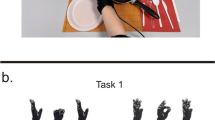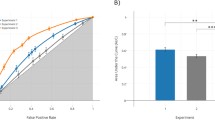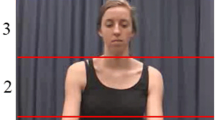Abstract
Imitation is a common and effective way for humans to learn new behaviors. Until now, the study of imitation has been hampered by the challenge of measuring how well an attempted imitation corresponds to its stimulus model. We describe a new method for quantifying the fidelity with which observers imitate complex series of gestures. Wearing a data glove that transduced movements of their digits, subjects viewed and then reproduced a sequence of gestures from memory. The velocity profile of each digit’s flexion or extension was used to segment movements made during an imitation into gestures that can be compared against corresponding gestures in the stimulus model. The outcome is a multivariate description of each imitation, including its temporal characteristics, as well as spatial errors (in individual gestures and in the ordering of those gestures). As a demonstration, we applied this method to data from an imitation learning experiment with gesture sequences. With repetition, overall fidelity of imitation improved, with various aspects of the imitation improving at different rates. Confirming the approach’s usefulness, when we varied the complexity associated with imitation, that variation was robustly reflected in our measures of imitation quality. Finally, we describe a simple way to extend our methods to make them useful not only in assessing imitation and imitation learning, but also in various settings in which the detection and characterization of subtle abnormalities in movement production is paramount.






Similar content being viewed by others
Notes
Tweening is an animation technique that interpolates the differences between two existing key frames in an animation timeline. Tweening can operate on differences between the pre-existing frames, in attributes such as scale, opacity, location, color and shape.
References
Agam Y, Bullock D, Sekuler R (2005) Imitating unfamiliar sequences of connected linear motions. J Neurophysiol 94:2832–2843
Agam Y, Galperin H, Gold BJ, Sekuler R (2007) Learning to imitate novel motion sequences. J Vis 7:1–17
Agam Y, Sekuler R (2007) Interactions between working memory and visual perception: an ERP/EEG study. Neuroimage 36:933–942
Buxbaum L, Johnson-Frey S, Bartlett-Williams M (2005) Deficit internal models for planning hand-object interactions in apraxia. Neuropsychologia 43:917–929
Conrad R (1960) Serial order intrusions in immediate memory. Br J Psychol 51:45–48
Ebbinghaus H (1885/1913) Memory: a contribution to experimental psychology. Teachers College, Columbia University, New York
Fish J, Soechting JF (1992) Synergistic finger movements in a skilled motor task. Exp Brain Res 91:327–334
Haaland K, Harrington D, Knight R (2000) Neural representations of skilled movement. Brain 123:2306–2313
Häger-Ross C, Schieber MH (2000) Quantifying the independence of human finger movements: comparisons of digits, hands, and movement frequencies. J Neurosci 20:8542–8550
Halsband U, Schmitt J, Weyers M, Binkofski F, Grutzner G, Freund HJ (2001) Recognition and imitation of pantomimed motor acts after unilateral parietal and premotor lesions: a perspective on apraxia. Neuropsychologia 39:200–216
Hamilton AF, Brindley RM, Frith U (2007) Imitation and action understanding in autistic spectrum disorders: how valid is the hypothesis of a deficit in the mirror neuron system? Neuropsychologia 45:1859–1868
Heilman K, Rothi L (2003) Apraxia. In: Heilman K, Valenstein E (eds) Clinical neuropsychology. Oxford University Press, New York
Hlustík P, Solodkin A, Gullapalli R, Noll D, Small S (2001) Somatotopy in human primary motor and somatosensory hand representations revisited. Cereb Cortex 11:312–321
Iacoboni M (2005) Neural mechanisms of imitation. Curr Opin Neurobiol 15:632–637
Iacoboni M, Dapretto M (2006) The mirror neuron system and the consequences of its dysfunction. Nat Rev Neurosci 7:942–951
Iacoboni M, Woods RP, Brass M, Bekkering H, Mazziotta JC, Rizzolatti G (1999) Cortical mechanisms of human imitation. Science 286:2526–2528
Jax S, Buxbaum L, Moll A (2006) Deficits in movement planning and intrinsic coordinate control in ideomotor apraxia. J Cogn Neurosci 18:2063–2076
Jerde TE, Soechting JF, Flanders M (2003) Coarticulation in fluent fingerspelling. J Neurosci 23:2383–2393
Kimura D (1993) Neuromotor mechanisms in human communication (no. 20). Oxford University Press, New York
Lashley KS (1951) The problem of serial order in behavior. In: Jeffress LA (ed) Cerebral mechanisms in behavior. Wiley, New York, pp 112–136
Lee CL, Estes WK (1977) Order and position in primary memory for letter strings. J Verbal Learn Verbal Behav 16:395–418
Lewandowsky S, Murdock BB (1989) Memory for serial order. Psych Rev 96:25–57
Li ZM, Davis G, Gustafson NP, Goitz RJ (2006) A robot-assisted study of intrinsic muscle regulation on proximal interphalangeal joint stiffness by varying metacarpophalangeal joint position. J Orthop Res 24:407–415
Loehr JD, Palmer C (2007) Cognitive and biomechanical influences in pianists’ finger tapping. Exp Brain Res 178:518–528
Mataríc MJ, Eriksson J, Feil-Seifer DJ, Winstein CJ (2007) Socially assistive robotics for post-stroke rehabilitation. J Neuroeng Rehabil 4:5
Oldfield R (1971) The assessment and analysis of handedness: the Edinburgh inventory. Neuropsychologia 9:97–113
Oztop E, Kawato M, Arbib M (2006) Mirror neurons and imitation: a computationally guided review. Neural Netw 19:254–271
Rao S, Binder J, Hammeke T, Bandettini P, Bobholz J, Frost J, Myklebust B, Jacobson R, Hyde J (1995) Somatotopic mapping of the human primary motor cortex with functional magnetic resonance imaging. Neurology 45:919–924
Rizzolatti G, Fadiga L, Gallese V, Fogassi L (1996) Premotor cortex and the recognition of motor actions. Brain Res 3:131–141
Rumiati R, Weiss P, Tessari A, Assmus A, Zilles K, Herzog H, Fink GR (2005) Common and differential neural mechanisms supporting imitation of meaningful and meaningless actions. J Cogn Neurosci 17:1420–1431
Sanes J, Donoghue J, Thangaraj V, Edelman R, Warach S (1995) Shared neural substrates controlling hand movements in human motor cortex. Science 268:1775–1777
Sanes J, Schieber M (2001) Orderly somatotopy in primary motor cortex: does it exist? Neuroimage 13:968–974
Schieber M, Santello M (2004) Hand function: peripheral and central constraints on performance. J Appl Physiol 96:2293–2300
Sunderland A (2007) Impaired imitation of meaningless gestures in ideomotor apraxia: a conceptual problem not a disorder of action control?: a single case investigation. Neuropsychologia 45:1621–1631
Sunderland A, Shinner C (2007) Ideomotor apraxia and functional ability. Cortex, 43:359–367
Vanvuchelen M, Roeyers H, De Weerdt W (2007) Nature of motor imitation problems in school-aged males with autism: how congruent are the error types? Dev Med Child Neurol 49:6–12
Vlachos M, Kollios G, Gunopulos D (2002) Discovering similar multidimensional trajectories. In: Proceeding of 18th International Conference on Data Engineering. IEEE Press, New York, pp 673–684
Whitehead RL, Schiavetti N, Whitehead BH, Metz DE (1997) Effect of sign task on speech timing in simultaneous communication. J Commun Disord 30:439–454
Zacks JM, Tversky B (2001) Event structure in perception and conception. Psychol Bull 127:3–21
Zacks JM, Tversky B, Iyer G (2001) Perceiving, remembering, and communicating structure in events. J Exp Psychol Gen 130:29–58
Author information
Authors and Affiliations
Corresponding author
Additional information
Supported by NSF grant SBE-0354378. A preliminary version of this work was presented in 2007 at the Eleventh International Conference on Cognitive and Neural Systems, Boston, MA.
Rights and permissions
About this article
Cite this article
Gold, B.J., Pomplun, M., Rice, N.J. et al. A new way to quantify the fidelity of imitation: preliminary results with gesture sequences. Exp Brain Res 187, 139–152 (2008). https://doi.org/10.1007/s00221-008-1291-2
Received:
Accepted:
Published:
Issue Date:
DOI: https://doi.org/10.1007/s00221-008-1291-2




